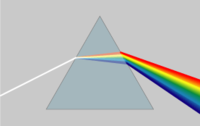
Photo from wikipedia
The present study investigates the event-related oscillations underlying the motion-onset response (MOR) evoked by sounds moving at different velocities. EEG was recorded for stationary sounds and for three patterns of… Click to show full abstract
The present study investigates the event-related oscillations underlying the motion-onset response (MOR) evoked by sounds moving at different velocities. EEG was recorded for stationary sounds and for three patterns of sound motion produced by changes in interaural time differences. We explored the effect of motion velocity on the MOR potential, and also on the event-related spectral perturbation (ERSP) and inter-trial phase coherence (ITC) calculated from the time-frequency decomposition of EEG signals. The phase coherence of slow oscillations increased with an increase in motion velocity similarly to the magnitude of cN1 and cP2 components of the MOR response. The delta-to-alpha inter-trial spectral power remained at the same level up to, but not including, the highest velocity, suggesting that gradual spatial changes within the sound did not induce non-coherent activity. Conversely, the abrupt sound displacement induced theta-alpha oscillations which had low phase consistency. The findings suggest that the MOR potential could be mainly generated by the phase resetting of slow oscillations, and the degree of phase coherence may be considered as a neurophysiological indicator of sound motion processing.
Journal Title: Brain Research
Year Published: 2021
Link to full text (if available)
Share on Social Media: Sign Up to like & get
recommendations!